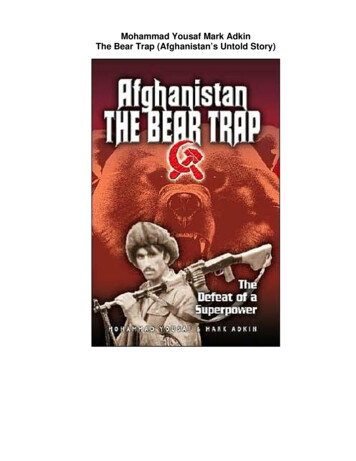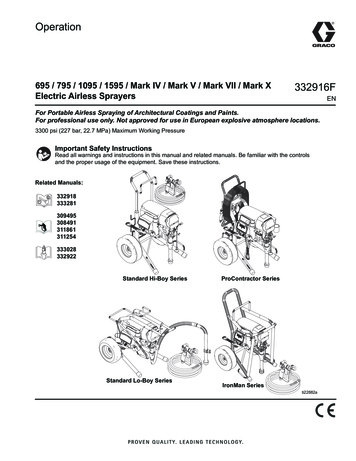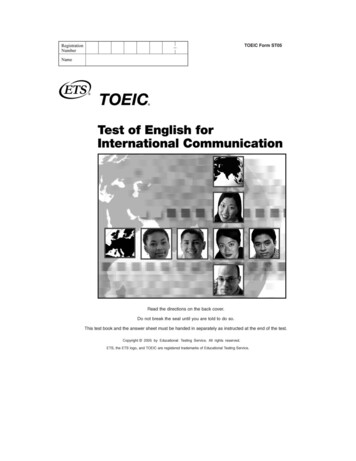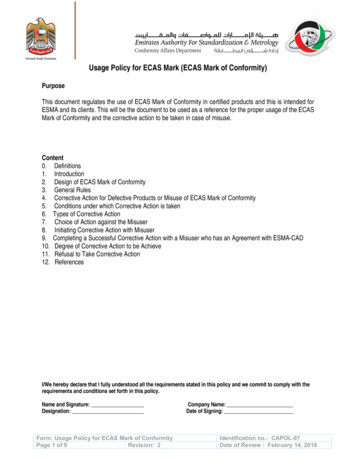
Transcription
Mohammad Yousaf Mark AdkinThe Bear Trap (Afghanistan’s Untold Story)
The Bear Trap(Afghanistan’sUntold Story)Mohammad YousafMark Adkin
PrefaceAt the start of this book, which tells the story of my part in the Afghan Jehad, I want toacknowledge the debt I, and indeed Pakistan and the Mujahideen owe to the ‘Silent Soldier’,General Akhtar Abdur Rahman. I served under him for four years at the height of the war, but hecarried the enormous responsibility for the struggle against what was then the Soviet superpower,for over eight years. I call him the ‘Silent Soldier’ because of his great humility and modesty. Fewpeople, apart from his family knew him as well as I did until he was assassinated, along withPresident Zia-ul-Haq, in the plane crash in August 1988. At one blow the Jehad lost its two mostpowerful leaders.When the Soviets invaded Afghanistan in 1979 President Zia sent for General Akhtar, whohad recently taken over as Director of ISI. At that time nobody in authority in Pakistan, andcertainly no overseas government (including the US), thought the Soviet military might could beconfronted. Afghanistan was written-off as lost. The only person within the military to advocatesupporting the Jehad by Pakistan, and the only person to come up with a plausible plan for doing so,was General Akhtar. He convinced the president that no only was it vital to Pakistan’s interests tofight the aggressors, but that there was every chance of defeating them. Some years later Zia was tosay to him, you have wrought a miracle, I can give you nothing worthy of your achievements. OnlyGod can reward you.My job during my time at ISI was to command the Afghan Bureau which was charged withthe day to day running of the Afghan war. General Akhtar was my superior, charged with devising,controlling and supervising the strategy to bring about victory in the field. Put in its simplest formhe was the strategist, while I was the tactician. At the outset he was almost alone in thinking that theSoviet Union with all its modern aircraft and armour could be brought down by a few thousandpoorly trained and armed Mujahideen. It certainly seemed an impossibility at the beginning. I recallbeing very skeptical myself when I first joined ISI on General Akhtar’s orders.As events were to show he was right. Under his leadership, under this order, under hisstrategy, the communist menace was not only confronted, but turned back–forced to retreat. Littlewonder that the chief architect of this humiliation was on the top of the KGB’s hit list with a hugeprice on his head. Nevertheless, during the time that I knew him he never wavered or showedconcern at the danger or, but continued to press on with the Jehad.I would venture to highlight two main areas in which General Akhtar’s influence was critical.The first was strategically. The whole concept of how to fight the war was his. He understood howeven a guerrilla army can defeat a superpower in the battlefield if it applied the strategy of death bya thousand cuts. Gradually, over the years, as the Mujahideen became better armed and trained thisstrategy of avoiding direct confrontation, of concentration on soft targets, on communications, andon supply lines and depots, brought about a full, scale Soviet withdrawal. Only after the removal ofGeneral Akhtar from ISI (and from the command of Mujahideen) did we deviate from thesemethods, such as when we attacked Jalalabad head on, and suffered a serious setback.At the centre of General Akhtar’s strategy lay the city of Kabul. Not that he wanted to take thecapital by storm–far from it. But he recognized its political, economic, social, and militarysignificance. His cry was ‘Kabul must burn’. It had to be cut off, its supply lines served, and it hadto be under continuous pressure year in year out. He knew that if a stranglehold on the city could beapplied it would fall without assault. His great wish was that he be able, after the war, to visit Kabulto offer prayers of thanksgiving for victory. Sadly it was not to happen.The second area of crucial influence was in the political/diplomatic field, I do not meaninternational politics or diplomacy, but rather internal affairs. General Akhtar seemed to me to bethe only person able to bring about a degree of unity among the fractious Mujahideen political
parties. Without that degree of cooperation nothing of importance could be achieved on the battlefield. He was able to unite, sometimes only temporarily I admit, leaders who were lifelong enemies.He was able to convince men who would not normally sit in the same room with each other to fight,together for the common goal of the Jehad.An important part of his success was in his ability to resist the ever growing pressure by theUS to run the war. Through the CIA the US sought to control the clandestine supply pipeline, armsdistribution, and the training of the Mujahideen. That they were not able to do so was entirely due toGeneral Akhtar’s efforts. It was a major contribution to a avoiding operational chaos.Unfortunately, General Akhtar was removed from the ISI by a promotion he did not seek justas the Mujahideen were on the brink of success. His tragic death a year later prevented him fromwitnessing the Soviet retreat from Afghanistan–the ultimate proof that he had won. I believe thatPakistan and Afghanistan owe a debt of gratitude to him. I certainly count it a great privilege tohave served under the only general in Pakistan’s short history to have masterminded a victory in amajor war and earn a name for his military genius. I salute him.BRIGADIER (RETD.) MOHAMMAD YOUSAF, S.Bt.A note on sourcesThe information for this book came almost entirely from personal experience andobservations during my time at ISI, and more recently when I returned to Peshawar. I know theMujahideen, some of their Commanders and all their Leaders well, We worked and plannedtogether for four years and I have discussed the situation today with many of them. This book,therefore, has not been written with extensive us of works of reference, or from the stories ofjournalist. I disagree with much that has been written about the war in Afghanistan. Sometimes thefacts are wrong, more often the interpretation is wrong. This does not mean that all books on thewar are valueless, far from it, but merely that I found very few to be reliable aids when compilingmy manuscript. Those that were included Mark Urban’s War in Afghanistan, Macmillan Press,1988; David C. Isby’s War in a Distant Country, Arms and Armour Press, 1986; and Robert D.Kaplan’s Soldiers of God, Houghton Mifflin Company, Boston 1990. Of these I found thefirst-mentioned to be particularly authentic and accurate.IntroductionDEATH by thousand cuts–this is the time-honoured tactic of the guerrilla army against a largeconventional force. In Afghanistan it was the only way to bring the Soviet bear to its knees; the onlyway to defeat a superpower on the battlefield with ill-trained, ill-disciplined and ill-equippedtribesmen, whose only asset was an unconquerable fighting spirit welded to a warrior tradition.Ambushes, assassinations, attack on supply convoys, bridges, pipelines, and airfields, with theavoidance of set piece battle; these are history’s proven techniques for the guerrilla. For four years,from 1983-87, it was my task to plan and coordinate these activities.I was an infantry brigadier in the Pakistan Army when I was suddenly summoned to take overthe Afghan Bureau of the Inter-Services Intelligence (ISI). I went reluctantly, and with foreboding.The ISI has, like most covert intelligent organizations and intimidating reputation both inside andoutside the Services. It is considered to be the most effective intelligence agency in the third world.It is also vast, with hundreds of officers, both military and civil, and thousands of staff. Its head theDirector General–who was the then Lieutenant-General Akhtar Abdul Rehman Khan, was the mostpowerful man in the armed forces, with daily direct access to President Zia.When I received the news of my posting over the telephone I was a brigade commander on a
divisional exercise at Quetta. I could not believe it, and asked the staff officer to recheck as I hadnever had intelligence training, never held an intelligence appointment, and so felt sure there hadbeen an error. To my dismay three had not. I was to report to Islamabad within 72 hours. It wasunbelievable. For a while I thought it was the end of my professional career. Such a posting isgenerally not welcomed by senior officers as, invariably, you make more enemies than friends.Overnight you become a different person in the eyes of your peers. Even superiors outside the ISIregard you with deep suspicion, as part of the ISI’s function is to keep careful watch on the generalsto ensure reliability to the regime. Certainly in those days of martial law under Zia, apprehension,even fear, of what the ISI could do was very real.The next day General Akhtar telephoned me and I took the opportunity to protest that I hadneither the experience nor the aptitude for a job within the ISI. His curt response was that neitherhad he when he first took over as Director General. He did, however, assure me that the job he hadin mind would be to my liking. And so it was.As it turned out I was not directly involved in intelligence gathering. My duties, month aftermonth, year after year, involved operations; operations against the second most powerfulsuperpower in the world–the USSR. It was the most momentous challenge of my life. Theresponsibility was frightening. As Director of the Afghan Bureau of the ISI I was tasked not onlywith training and arming the Mujahideen (Soldiers of God), but planning their operations insideAfghanistan. When I looked at the enemy order of battle on the map in my operation room Icounted no fewer than one 4 star, five 3 star, and some fifteen 2 star Soviet generals, not to mentionat least twenty-five Afghans, all of whom outranked me.Throughout my time in the ISI I was concerned with formulating and implementing a militarystrategy to defeat the Soviets. My aim was to make Afghanistan their Vietnam. Operations were ofcourse also directed against the communist Afghan Army, but I emphasize that my main enemy wasthe USSR. It was the invader. Without its massive presence the conflict would have been over longbefore I took up my post in October, 1983. My duties were military. Although I was keenly awareof the effect of politics on the outcome of the fighting I was seldom, if ever, directly involved inpolitical decision-making. Nevertheless, as time went on, the whims and prejudices of politicians,including those within the Mujahideen, often made the actual fighting of the war a nightmare offrustrations and disappointments. Had it not been for General Akhtar, my only superior during mostof my time in the ISI, shielding me from the political intrigues I would surely have resigned withinmonths.Despite this the reader will need to understand that there are seven recognized Mujahideenpolitical parties, headquartered in exile, in Pakistan, each with a leader. Of these, four can bebroadly classified as Islamic Fundamentalists, while three are Islamic Moderates. They are referredto in the text as the ‘Parties’ or the ‘Party Leader’. These Leaders are not to be confused with theMujahideen commanders in the field. They all belong to one of the Parties, but are termedCommanders.My time, until late in 1987 when I retired from the Army, was spent in trying to organize andadminister rival Mujahideen groups so that they might present some sort of unity on the battlefield.I had to attempt to coordinate one of the largest guerrilla campaigns in modern times, with a staff ofsixty officers and 300 senior NCOs and men from the Pakistan Army. To the Mujahideen I couldissue no order–an advantage taken for granted by my Soviet and Afghan opponents. I had toachieve operational results by cajoling and convincing, not commanding. Somehow I must continueto improve and develop on what had been achieved by my predecessor so that eventually the tacticsof a thousand cuts would produce such a haemorrhaging of men and money that the burden wouldbe unbearable.I was compelled to operate under an elaborate smokescreen of secrecy. Most senior generalsof the Pakistan Army had no idea of my duties. Even my family was unaware of the real nature ofmy task. This need for absolute anonymity stemmed from the official denial of the government thatPakistan was aiding the Mujahideen. No one in authority would admit that weapons, ammunitionand equipment were being channelled through Pakistan, by Pakistanis, to the guerrillas. Even more
taboo was the fact that the ISI was training the Mujahideen, planning their combat operations, andoften accompanying them inside Afghanistan as advisers. Of course the arms supply was an opensecret; everybody knew it was happening, but although the involvement of Pakistan in the field wasguessed at, it was never, ever, publicly admitted. Throughout the war the diplomats kept playingtheir game of pretence with Pakistani ambassadors in Moscow and Kabul, and a Soviet one inIslamabad.Because the role of Pakistan was so sensitive, because I had no wish to embarrass my country,or jeopardize its security, and would do nothing that might prejudice operations against the Soviets,the writing of this book was delayed. When I retired in August, 1987, the Geneva Accord had yet tobe signed, no Soviet withdrawal had started, but the Mujahideen were gaining the upper hand.There was little doubt that the USSR had enough. Mujahideen military victory was in sight.Although I spent the early months of my retirement recording the highlights of my time with theISI, it was not my intention to write a book. Indeed, I was most strongly advised against such acourse. Now, in late 1991, there is no danger of compromising either state secrets or the prosecutionof the Jehad. The once covert activities of the Mujahideen, ISI, or Pakistan, are no longer secret, butcommon knowledge in my country, if not outside. With the retreat of the Soviets what I haveexposed of the struggle against them is no longer of operational importance. Today all trainingactivities by Pakistan have ceased, the training camps have been abandoned, ISI personnel do notenter inside Afghanistan, and Mujahideen no longer raid across the Amu River into the SovietUnion.Even the system of distribution of arms has changed, while the quantity has been substantiallyreduced. The Military Committee of Afghan leader with which I worked on planning operation, hasbeen disbanded, and a new system of control by the Afghan Interim Government (AIG) substituted.So I am persuaded that this book may serve a useful purpose for posterity and for historians, if onlyto highlight lessons for political and military leaders.There is much to be learned, or rather re-learned, about the conduct of guerrilla warfare fromthe Afghanistan experience. If some of these can be assimilated and applied in the future thenwriting this book will have been worthwhile.After three years, things have changed for the worse with the Mujahideen in Afghanistan. InFebruary, 1989, when the last Soviet soldier crossed back into the USSR everybody expected aMujahideen victory within weeks. In Kabul resistance was on the point of collapse, its citizensfaced starvation, the Afghan Army was supposedly about to surrender, and foreign diplomats werepacking their bags. A second Saigon was about to happen. All Afghan watchers predicted aMujahideen triumph, they only differed as to whether it would come in weeks or months. It nevercame at all. To a soldier, who had been so intimately involved, it was a devastating disappointment.Somehow a Mujahideen defeat had been snatched from the jaws of victory. This book is an attemptto explain why.Nevertheless, I have not written a history of the Afghan war. My objective has been to set therecord straight with regard to how things happened, and why they happened. I seek to explain theworkings of a guerrilla army, how it operated, its failings as well as its merits, to record the reasons,as I see them why a triumph for the Mujahideen was denied them in the months following theSoviet withdrawal.Some, perhaps most, of the things I describe have never been made public before–hence thesub-title of the book–although I have been careful that nothing I say can damage current or futureoperations inside Afghanistan. For the first time the true extent of the assistance given by Pakistanto the Mujahideen in training, logistics and on operations is made known. During my four yearssome 80,000 Mujahideen were trained; hundreds of thousands of arms and ammunition weredistributed, several billion dollars were spent on this immense logistic exercise and ISI teamsregularly entered Afghanistan alongside the Mujahideen. Certainly some of the motives and actionsof the US to which I allude as being distinct possibilities will be denied–perhaps correctly. Where Ifeel that all is not it seems, where doubt exists as to the cause of events, such as the air crash thatkilled President Zia, I attempt to set out the known evidence honestly, and then draw conclusion.
These conclusion are entirely personal, but ones which I cannot wipe from my mind. Probably, Ishall for ever remain uncertain.Many books have been written on the war, some describe the cut and thrust of battle on bothsides, year by year, while others, more numerous, are merely accounts of journalist’s journeys withthe Mujahideen. Invariably these books flatter a particular Mujahideen Party of Commander,depending on who was the author’s host. It is extremely difficult for the media to know what ishappening in Afghanistan. First, it is so remote. There are no comfortable hotels, the fighting istaking place hundreds of miles away from Peshawar, in Pakistan, where most journalistscongregate. There is no way of dashing out after breakfast, watching or filming a shootout in thestreets, then getting a story to New York or London that evening. Secondly and arising from thefirst, there is the physical stamina required to go inside Afghanistan. The gruelling effort ofmarching for several weeks in those unforgiving mountains without proper food or shelter deters allbut the most hardy. Add to this the sickness and the danger and it is not surprising that MujahideenCommanders assess prospective companions with caution. Only a few get taken in. Then, at the endof it all, they may see no action. Their supreme efforts in keeping up for day after day are oftenpoorly rewarded in teams of a readable story.For a few all this was quite unacceptable, so they persuade a Commander to set up a mockbattle, sometimes with Mujahideen in Afghan uniforms, buildings wired for demolition in advance,all in true Hollywood style. The Mujahideen enthusiastically rushed around firing all type ofweapons, there was much smoke, much noise, much enjoyment and much filming. Of course thejournalists had to pay, give the Commander publicity and prestige, but the films sold well in the USor elsewhere. It was n altogether more civilized way to wage war, and for parties to make money.Even when writing a genuine article, it usually became a channel to promote the views andaspiration of the Commander who took them in. He is their here, his views are expounded, while thereader gets an overly extravagant picture of a personality, his performance and his importance.To avoid falling into this trap I have seldom mentioned Mujahideen Commanders by namewhen describing a particular operation. I have chosen examples that I believe to be typical of thefighting, some of which were failures, but I have not praised one Commander while disparaginganother on the basis of the old Army dictum, ‘No names, no pack drill’. Similarly, I have not namedpeople who are still serving, or who operated under the veil of secrecy, where this could damagetheir reputation or endanger their lives. Apart from this the names used are the real ones.Despite the above safeguards there will be some who oppose this book’s publication, if onlyfor the sake of perversity. My immediate superior at the time of my retirement, while showing aninterest in the idea, insisted that I should get any draft approved by the Army. This would have beenthe kiss of death to my efforts. The Pakistan military would have chopped it to pieces in their effortsto eliminate criticisms. So when, after two years, I decided to put my handwritten notes into a morepresentable form I could seek no official help.My first problem was that nobody in the family could type. I bought a typewriter andpersuaded my eldest daughter that she should learn on my manuscript. I give her credit for eightypages of laborious two-finger effort before she gave up on disgust. Next, I had to resort toletter-writers in Karachi, pretending that it was some sort of official paper rather than a book. Icould not just hand it over and await its completion. This would have been to court disaster, as whatI was doing would be public gossip within days. To use just one writer was out of the question so Ivisited five or six. To each I would give 15-20 pages to work on, while I stood around the shop,sometimes peering over his shoulder sometimes showing away other curious customers, andgenerally becoming thoroughly bored and frustrated. At the end of the day I would collect up all thepages and take them to the next man the following day. To type and correct over 400 pages at thisrate takes time, especially when I often had to wait up to a week before I could find a writeravailable. After a while I ran out of letter-writers, and had to start again with the first one. Adreadful experience.Still I was far from finished. If publication in Pakistan was going to involve endless bickeringand bureaucratic delays, with no guarantee of a book at the end of it all, then the answer seemed to
lie in the USA, my ally in the war. As a former ISI officer, whose inclination to write about hisexperiences was known to some, I resorted to sending the manuscript to a friend in New York, whointroduced me to Mark Adkin. This book is the outcome of the ensuing partnership.I have endeavored to convey the ‘flavour’ of this guerrilla war by describing my experiences,or those of others known to me, during my tenure with the ISI. It was, while the Soviets occupiedthe country, a campaign in which a late twentieth century army fought against an early nineteenthcentury one. The Afghans who annihilated the British during their winter retreat from Kabul in1842 were virtually identical to those indestructible fighters who killed over 13,000 Soviet soldiersand wounded some 35,000 and sent its army scurrying home after nine years of bitter fighting. Thepeople have not changed much over the centuries; even Alexander’s Macedonian pikemen whomarched up the Panjsher valley 2300 years ago would easily recognize the jagged, barren, rockyskyline today. Time does not change much in Afghanistan.To my knowledge the mystery of why the Mujahideen never marched into Kabul withinweeks of the Soviets withdrawal has never been fully explained. It has usually been put down tointernal feuding. I believe this is only part of the answer. To me the evidence, albeit circumstantial,points to a covert decision by their main backer–the US–that the Mujahideen should no be allowedan outright military victory. I believe they could have had their triumph despite their quarrels if ithad been in the US interests. Unfortunately it was not. Both superpowers are much moreconformable with the present stalemate.Nothing in this book is official history, but I have made every effort to get my facts correct.Any errors are mine, as are the opinion and comments. I wish to concede, without any reservations,that I could have achieved nothing during my time with ISI without the devoted, unstinting andunending labours of my officers and staff. They worked day and nights, without any publicrecognition, for the success of the Jehad. I owe them a lot. I hope that this book will, in a small way,be seen by them as an acknowledgement of their contribution.Finally, I salute the Mujahideen who, for all their faults, have once again proved anunbeatable opponent. No matter how many political reasons may have been espoused for theSoviet’s retreat from Afghanistan, they would never have gone without the efforts of these Soldiersof God.Prologue“Zia’s death must have been an act of God.”Benazir Bhutto, Daughter of Destiny, 1988.The CrashWhen the camouflage-painted Pakistan Air Force C-130 transport aircraft hit the ground it didso at an angle of 65 degrees. It was nose-diving, flaps up, wings level, landing gear up and locked,with all four engines functioning normally. It impacted at 190 knots. After a brief moment amonstrous ball of orange flame consumed it as the fuel tanks exploded. Both clocks in the flightdeck later showed 3.51 PM exactly on a clear, bright day, a few miles north of the small garrisontown of Bahawalpur. Precisely five minutes earlier it had lifted off at the start of its 70-minute flightto Islamabad. After some two minutes of terror all on board had the merciful relief of instantaneousoblivion.It was 17 August, 1988. Moments before Hafiz Taj Mohammad, who was walking towardshis field near the village of Dhok Kamal, near the Sutlej River eight miles north of Bahawalpur,heard the roar of engines and looked up. He watched incredulously as the lumbering plane, whichwas still rising steadily through 5000 feet, suddenly dropped its nose to fly almost straight at the
ground, before, with some superhuman effort, it climbed again. Then, as though its strength hadfinally gone, it plunged down to extinction. To the man below there was no outward reason, nomissile, no mid-air explosion, no fire, no engine trailing smoke, nothing to forewarn of such adisaster.Dead were the President of Pakistan, General Zia-ul-Haq, and the man who might havesucceeded him had he survived, General Akhtar Abdul Rahman Khan, Chairman of the Joint Chiefsof Staff Committee. Gone were the two most powerful men in Pakistan, the head of state and theman who for eight years until 1987, and headed the ISI. At a stroke the Afghan resistance fighters,the Mujahideen, had lost their two most influential champions. Dead were the US Ambassador, Mr.Arnold Raphel, who had known the President for twelve years, and Brigadier-General HerbertWassom, the US Defense Attachй in Islamabad. Dead also were eight Pakistani generals with theirstaff, and the crew–thirty-one persons in all.Disquietingly, neither President Zia nor General Akhtar should have been abroad the plane.Both had been persuaded against their wishes to attend a demonstration of a solitary American M-Ibattle tank, which the US was keen to sell to the Pakistan Army. It was not a function that requiredtheir presence. Such a comparatively low-level event would normally have been handled by theVice Chief of Army Staff, General Mirza Aslam Beg. It was the first time Zia had left the heavysecurity of his official residence since he had dismissed the government of Prime Minister Junejothree months before.It was only on 14 August that Zia had finally given in to the pressure from his former militarysecretary and Defence Attachй in Washington, Major-General Mehmood Durrani, nowcommanding the armoured division. He insisted that the President’s presence was diplomaticallydesirable, and would give added weight to the Pakistani delegation. After all Zia had retained thepost of Chief of Army Staff. Against his better judgement he agree to go.Similarly, General Akhtar had no intention of going to Bahawalpur until a mere twelve hoursbeforehand. His change of mind was brought about by the persistent phone calls of a formerdirector in ISI, to the effect that Zia was about to make some controversial changes in the militaryhierarchy about which Akhtar should know. Akhtar consulted with the President, asking for anurgent meeting. Zia, who was then committed to the tank demonstration trip, suggested Akhtaraccompany him as they could discuss things on the aircraft. The fate of both was sealed.The callsign of the President’s plane was PAK 1, but the actual aircraft he would use was notselected until shortly before the flight. Usually two of the C-130s based at the Air Force base atChaklala, a few miles from Islamabad, were earmarked. Then, once the decision was taken, the VIPpassenger capsule could be rolled into the aircraft and secured shortly before take off. This was a21-foot-long by 8-foot-wide plywood and metal structure weighing 5000 pounds, which was fittedout to give some comfort, including an independent air conditioning and lighting system, to anotherwise notoriously uncomfortable aircraft interior. The second aircraft, PAK 2, would followPAK 1 as a backup. There was routine security search of both planes prior to departure. For thisflight there was a problem. The airstrip at Bahawalpur was small and could only accommodate oneC-130, so PAK 2 would land 150 kilometers away at Sargodha. Once the President left Chaklalathere was no possibility of his changing aircraft.There would, however, be two other smaller planes on the airfield. The first was the Cessnawhose task was to circle the vicinity of the airport as a precaution against missile-armed terrorists.This had been routine practice since an unsuccessful missile attack six years earlier. Then there wasthe eight-seater plane of General Beg who, as the official host, had to get the small jet that wouldtake him and the ambassador south would be parked at Multan. If the crash was sabotage the twoAmericans were not part of the target.The actual demonstration, in front of so much Army brass, was a big embarrassment to theAmericans. The much-vaunted Abrams tank failed to score many hits and the billion dollar dealevaporated in the enervating heat.While the President and the se
war are valueless, far from it, but merely that I found very few to be reliable aids when compiling my manuscript. Those that were included Mark Urban's War in Afghanistan, Macmillan Press, 1988; David C. Isby's War in a Distant Country, Arms and Armour Press, 1986; and Robert D. Kaplan's Soldiers of God, Houghton Mifflin Company, Boston .










